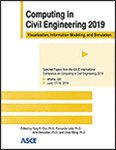ASCE International Conference on Computing in Civil Engineering 2019
Virtual Manipulation in an Immersive Virtual Environment: Simulation of Virtual Assembly
Publication: Computing in Civil Engineering 2019: Visualization, Information Modeling, and Simulation
ABSTRACT
To fill the lack of research efforts in virtual assembly of modules and training, this paper presents a virtual manipulation of building objects in an immersive virtual environment (IVE). A worker wearing a virtual reality (VR) head-mounted device (HMD) virtually perform an assembly of multiple modules while identifying any issues. Hand motions of the worker are tracked by a motion sensor mounted on the HMD. The worker can be graded based on his/her overall performance and speed during this VR simulation. The developed VR simulation can ultimately enable workers to identify unforeseen issues (e.g., not enough clearance for an object to be installed). The presented method can solve current deficiencies in discrepancy detection in 3D scanned models of elements. The developed VR platform can also be used for interactive training and simulation sessions that can potentially improve efficiency and help achieve better work performance for assemblies of complex systems.
Get full access to this article
View all available purchase options and get full access to this chapter.
REFERENCES
“Artec Eva.” (2018). <https://www.artec3d.com/portable-3d-scanners/artec-eva> (Feb. 12, 2018).
Asadi, K., and Han, K. (2018). “Real-Time Image-to-BIM Registration Using Perspective Alignment for Automated Construction Monitoring.” Construction Research Congress 2018, American Society of Civil Engineers, Reston, VA, 388–397.
Asadi, K., Jain, R., Qin, Z., Sun, M., Noghabaei, M., Cole, J., Han, K., and Lobaton, E. (2019a). “Vision-based Obstacle Removal System for Autonomous Ground Vehicles Using a Robotic Arm.” Computing in Civil Engineering 2019.
Asadi, K., Ramshankar, H., Noghabaee, M., and Han, K. (2019b). “Real-time Image Localization and Registration with BIM Using Perspective Alignment for Indoor Monitoring of Construction.” Journal of Computing in Civil Engineering.
Asadi, K., Ramshankar, H., Pullagurla, H., Bhandare, A., Shanbhag, S., Mehta, P., Kundu, S., Han, K., Lobaton, E., and Wu, T. (2018a). “Building an Integrated Mobile Robotic System for Real-Time Applications in Construction.” arXiv preprint arXiv:1803.01745.
Asadi, K., Ramshankar, H., Pullagurla, H., Bhandare, A., Shanbhag, S., Mehta, P., Kundu, S., Han, K., Lobaton, E., and Wu, T. (2018b). “Vision-based integrated mobile robotic system for real-time applications in construction.” Automation in Construction, Elsevier, 96, 470–482.
Balali, V., Noghabaei, M., Heydarian, A., and Han, K. (2018). “Improved Stakeholder Communication and Visualizations: Real-Time Interaction and Cost Estimation within Immersive Virtual Environments.” Construction Research Congress 2018, 522–530.
Boroujeni, K. A., and Han, K. (2017). “Perspective-Based Image-to-BIM Alignment for Automated Visual Data Collection and Construction Performance Monitoring.” Congress on Computing in Civil Engineering, Proceedings, 171–178.
Bosché, F., Ahmed, M., Turkan, Y., Haas, C. T., and Haas, R. (2015). “The value of integrating Scan-to-BIM and Scan-vs-BIM techniques for construction monitoring using laser scanning and BIM: The case of cylindrical MEP components.” Automation in Construction, Elsevier, 49, 201–213.
Fathi, H., Dai, F., and Lourakis, M. (2015). “Automated as-built 3D reconstruction of civil infrastructure using computer vision: Achievements, opportunities, and challenges.” Advanced Engineering Informatics, Elsevier, 29(2), 149–161.
Golparvar-Fard, M., Bohn, J., Teizer, J., Savarese, S., and Peña-Mora, F. (2011). “Evaluation of image-based modeling and laser scanning accuracy for emerging automated performance monitoring techniques.” Automation in Construction, Elsevier, 20(8), 1143–1155.
Han, K., Degol, J., and Golparvar-Fard, M. (2018). “Geometry- and Appearance-Based Reasoning of Construction Progress Monitoring.” Journal of Construction Engineering and Management, 144(2), 04017110.
Heydarian, A., Carneiro, J. P., Gerber, D., and Becerik-gerber, B. (2015). “Immersive virtual environments, understanding the impact of design features and occupant choice upon lighting for building performance.” Building and Environment, Elsevier Ltd, 89, 217–228.
Hilfert, T., and König, M. (2016). “Low-cost virtual reality environment for engineering and construction.” Visualization in Engineering, Springer International Publishing, 4(1), 2.
Kayhani, N., Taghaddos, H., Noghabaee, M., Ulrich, and Hermann. (2019). “Utilization of Virtual Reality Visualizations on Heavy Mobile Crane Planning for Modular Construction.” arXiv e-prints, arXiv:1901.06248.
Nahangi, M., Czerniawski, T., Haas, C. T., Walbridge, S., and West, J. (2016). “Parallel Systems and Structural Frames Realignment Planning and Actuation Strategy.” Journal of Computing in Civil Engineering, 30(4), 04015067.
Nahangi, M., and Haas, C. T. (2016). “Skeleton-based discrepancy feedback for automated realignment of industrial assemblies.” Automation in Construction, Elsevier, 61, 147–161.
Paes, D., Arantes, E., and Irizarry, J. (2017). “Immersive environment for improving the understanding of architectural 3D models: Comparing user spatial perception between immersive and traditional virtual reality systems.” Automation in Construction, Elsevier, 84, 292–303.
Salama, T., Moselhi, O., and Al-Hussein, M. (2018). “Modular Industry Characteristics and Barrier to its Increased Market Share.” (April).
Son, H., Bosché, F., and Kim, C. (2015). “As-built data acquisition and its use in production monitoring and automated layout of civil infrastructure: A survey.” Advanced Engineering Informatics, Elsevier, 29(2), 172–183.
State, N. C., and State, N. C. (2017). “Development of Immersive Personalized Training Environment for Construction Workers Idris Jeelani 1 ; Kevin Han 2 ; and Alex Albert 3 1.” 407–415.
United States Census Bureau. (2018). Monthly Construction Spending.
Information & Authors
Information
Published In
Computing in Civil Engineering 2019: Visualization, Information Modeling, and Simulation
Pages: 95 - 102
Editors: Yong K. Cho, Ph.D., Georgia Institute of Technology, Fernanda Leite, Ph.D., University of Texas at Austin, Amir Behzadan, Ph.D., Texas A&M University, and Chao Wang, Ph.D., Louisiana State University
ISBN (Online): 978-0-7844-8242-1
Copyright
© 2019 American Society of Civil Engineers.
History
Published online: Jun 13, 2019
Authors
Metrics & Citations
Metrics
Citations
Download citation
If you have the appropriate software installed, you can download article citation data to the citation manager of your choice. Simply select your manager software from the list below and click Download.
